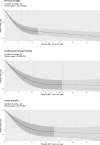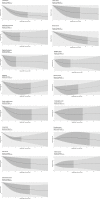Non-occupational physical activity and risk of cardiovascular disease, cancer and mortality outcomes: a dose-response meta-analysis of large prospective studies
- PMID: 36854652
- PMCID: PMC10423495
- DOI: 10.1136/bjsports-2022-105669
Non-occupational physical activity and risk of cardiovascular disease, cancer and mortality outcomes: a dose-response meta-analysis of large prospective studies
Abstract
Objective: To estimate the dose-response associations between non-occupational physical activity and several chronic disease and mortality outcomes in the general adult population.
Design: Systematic review and cohort-level dose-response meta-analysis.
Data sources: PubMed, Scopus, Web of Science and reference lists of published studies.
Eligibility criteria: Prospective cohort studies with (1) general population samples >10 000 adults, (2) ≥3 physical activity categories, and (3) risk measures and CIs for all-cause mortality or incident total cardiovascular disease, coronary heart disease, stroke, heart failure, total cancer and site-specific cancers (head and neck, myeloid leukaemia, myeloma, gastric cardia, lung, liver, endometrium, colon, breast, bladder, rectum, oesophagus, prostate, kidney).
Results: 196 articles were included, covering 94 cohorts with >30 million participants. The evidence base was largest for all-cause mortality (50 separate results; 163 415 543 person-years, 811 616 events), and incidence of cardiovascular disease (37 results; 28 884 209 person-years, 74 757 events) and cancer (31 results; 35 500 867 person-years, 185 870 events). In general, higher activity levels were associated with lower risk of all outcomes. Differences in risk were greater between 0 and 8.75 marginal metabolic equivalent of task-hours per week (mMET-hours/week) (equivalent to the recommended 150 min/week of moderate-to-vigorous aerobic physical activity), with smaller marginal differences in risk above this level to 17.5 mMET-hours/week, beyond which additional differences were small and uncertain. Associations were stronger for all-cause (relative risk (RR) at 8.75 mMET-hours/week: 0.69, 95% CI 0.65 to 0.73) and cardiovascular disease (RR at 8.75 mMET-hours/week: 0.71, 95% CI 0.66 to 0.77) mortality than for cancer mortality (RR at 8.75 mMET-hours/week: 0.85, 95% CI 0.81 to 0.89). If all insufficiently active individuals had achieved 8.75 mMET-hours/week, 15.7% (95% CI 13.1 to 18.2) of all premature deaths would have been averted.
Conclusions: Inverse non-linear dose-response associations suggest substantial protection against a range of chronic disease outcomes from small increases in non-occupational physical activity in inactive adults. PROSPERO registration number CRD42018095481.
Keywords: epidemiology; health; meta-analysis; noncommunicable diseases; physical activity.
© Author(s) (or their employer(s)) 2023. Re-use permitted under CC BY. Published by BMJ.
Conflict of interest statement
Competing interests: None declared.
Figures




References
-
- Global Burden of Disease Cancer Collaboration, Fitzmaurice C, Allen C, et al. . Global, regional, and National cancer incidence, mortality, years of life lost, years lived with disability, and disability-adjusted life-years for 32 cancer groups, 1990 to 2015: a systematic analysis for the global burden of disease study. JAMA Oncol 2017;3:524–48. 10.1001/jamaoncol.2016.5688 - DOI - PMC - PubMed
Publication types
MeSH terms
Grants and funding
LinkOut - more resources
Full Text Sources
Other Literature Sources
Medical
